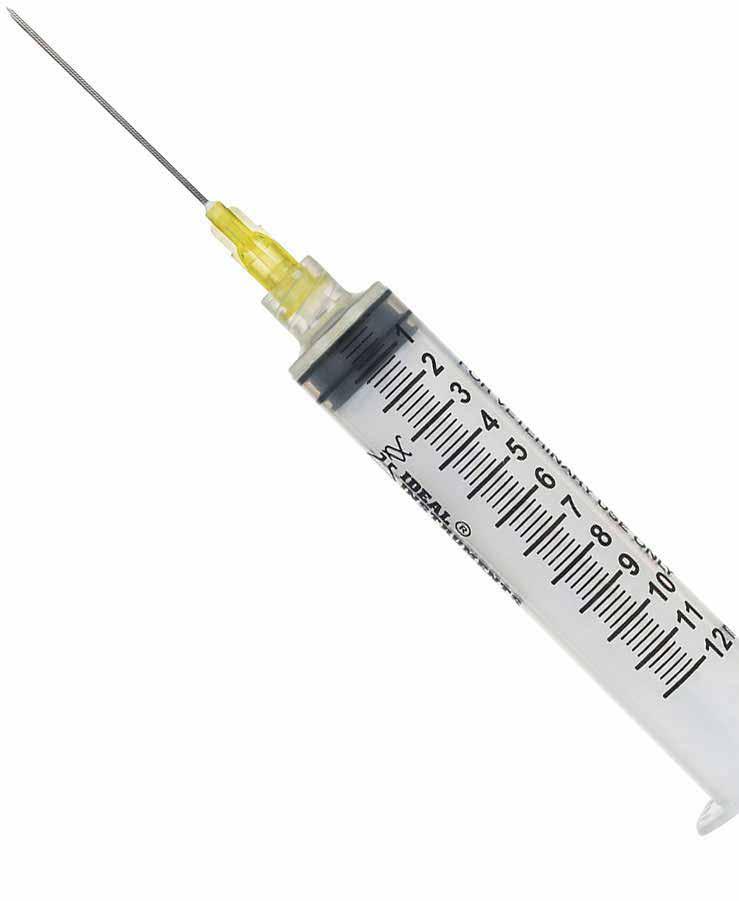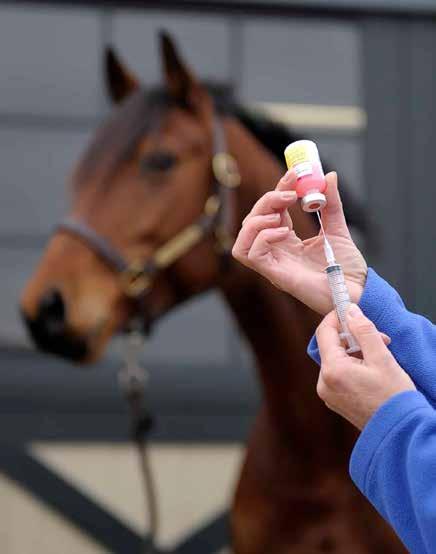
7 minute read
Equine Vaccinations
There is not a standard vaccine program for all horses. Instead, each individual horse requires a protocol based on the following criteria: • Risk of disease (age, breed, use, anticipated exposure, environmental factors, geographic factors, etc) • Consequences of disease (prevalence, mortality, risk of human infection) • Effectiveness of selected products • Potential for adverse reaction to vaccines • Cost of immunization vs. potential cost of disease Realistically, it should be understood that: • In the absence of good management practices for disease control, vaccination alone may not be enough to prevent infectious disease • Vaccination minimizes the risk of infection, but cannot prevent disease in all circumstances • Vaccines do not provide immediate protection to a patient, and boosters must be initially given to activate proper immunity • Primary vaccines and booster doses should be administered prior to a likely exposure • Every horse in a population is not protected to the same degree or duration with each vaccination • There is always the potential for an adverse reaction to a vaccine despite their appropriate handling and administration. Ideally, the same schedule is followed for all horses in a population. This minimizes the transmission of infectious disease in a herd and protects horses in the herd that respond poorly to vaccination (herd immunity). The American Association of Equine Practitioners (AAEP) has established core vs. non-core vaccination recommendations. A core vaccine is described as one which protects from disease that is prevalent in a region, poses a potential danger to public health, is required by law, is highly infectious, and/or poses risk of severe disease. Core vaccines have established efficacy and safety, and therefore have a high enough level of benefit to offset the risk associated with their use. The following vaccines are described as core vaccines: Eastern/ Western Equine Encephalomyelitis, Tetanus, Rabies, and West Nile Virus. Following is a description of an ideal vaccination protocol for horses in the southeastern US. Since the southeast has an active mosquito population year round, typically horses are vaccinated more aggressively against mosquito-borne diseases in this area. The following vaccination protocol is for horses which have received the complete series of booster
vaccinations and are regularly vaccinated. Different protocols exist for horses which have never been vaccinated, pregnant mares, and foals. Please speak to your veterinarian before instituting a vaccine protocol for these groups of horses.
Advertisement
Eastern and Western Equine Encephalomyelitis (EWT)
Eastern Equine Encephalomyelitis (EEE) is most present in the south-eastern US. Western Encephalomyelitis (WEE) is typically reported in the western and mid-western states; however, there have been sporadic outbreaks of WEE in Florida. Venezuelan (VEE) occurs in Central and South America, and has not been reported in the US for 40 years. Horses typically receive an EEE/WEE combination vaccination, which may be partially protective against VEE infection. EEE/ WEE/VEE is transmitted by mosquitoes from wild birds and rodents. Humans are also susceptible to these diseases through mosquito bites. Transmission of any of these viruses from horse to horse or from horse to human is highly unlikely. WEE has a mortality of approximately 50% and EEE of approximately 90%. Research has shown that young horses are very susceptible to disease caused by EEE virus. Since mosquitoes are active year round in Florida, vaccination for EEE/WEE is recommended every 6 months. Typically the vaccination used is a combination vaccine of EEE and WEE with tetanus, commonly called “EWT.”
Tetanus Vaccination
Tetanus is caused by the bacterium Clostridium tetani. C. tetani is found in the intestinal tract and feces of horses, other animals, and humans, as well as in the soil. C. tetani is a hardy bacterium, and can survive in many environments for long periods of time. Tetanus is not contagious; instead, infection is due to the bacterium infecting wounds, surgical incisions, the umbilical cord of foals, and the reproductive tract of mares after foaling. There are two types of tetanus vaccines: toxoid and antitoxin. The toxoid vaccine is what is used to regularly vaccinate horses. The antitoxin is only used in specific cases where an injured horse has never received a tetanus vaccine. Typically horses are vaccinated for tetanus with a tetanus toxoid on an annual basis. Horses that sustain a wound or undergo surgery more than 6 months following their latest tetanus booster should be immediately revaccinated with the tetanus toxoid vaccine.
West Nile Vaccination
West Nile Virus (WNV) is one of the leading causes of encephalitis in horses and humans in the United States. Since 1999, horses represent 96.9% of all non-human mammalian cases of WNV. WNV has been identified in the entire continental US, most of Canada and Mexico. The virus is transmitted by mosquitoes from bird hosts to horses, humans and other mammals. Humans and horses are dead-end hosts for WNV. There have not been reports
of transmission of WNV from infected horses to other horses. The fatality rate from horses exhibiting clinical signs of WNV is approximately 33%. Current data states that 40% of horses that survive WNV exhibit residual effects 6 months after infection. The vaccine for WNV is used to aid in prevention of disease and/or to reduce the severity of clinical disease. Typically horses are vaccinated for WNV annually in the spring, prior to the start of mosquito season. For animals that have limited immunity (young or older horses) more frequent vaccination maybe required in Florida.
Rabies Vaccination
While the incidence of rabies in horses is low, infection is fatal and there are significant public health risks of infection. Exposure to rabies is through the bite of an infected animal, typically wildlife. Usually bites occur on the face, muzzle or lower limbs. It is recommended that horses be vaccinated on an annual basis for rabies. Additionally, the AAEP describes non-core vaccines as risk-based vaccines. These vaccines are used in a vaccine program after evaluation of risk-benefit analysis. The use of risk-based vaccines can very regionally, on specific populations of horses or even between individual horses in a population. The following are available risk-based vaccines: Anthrax, Botulism, Strangles, Influenza, Herpesvirus, Equine Viral Arteritis (EVA), Potomac Horse Fever, Leptospirosis, Rotaviral Diarrhea, and Snake Bite. Typically our practice may utilize influenza, herpesvirus and/or strangles vaccine.
Strangles Vaccination
Strangles is caused by the bacteria Streptococcus equi subspecies equi. Strangles most typically affects immune compromised (young or geriatric horses). Vaccination is recommended where there has been a persistent problem, or for horses that are expected to have a high risk of exposure. The bacteria is spread through contact with infected horses, or water/feed troughs, stalls, trailers, tack, or contaminated humans. Typically we vaccinate with a live intranasal vaccine once a year.
Equine Influenza (Flu) Vaccination
Equine influenza is an extremely contagious virus that is rapidly spread through groups of horses through coughing. Horses at most risk for infection are young horses (1-5 years of age) or horses in frequent contact with large populations of horses (horse shows). Mature performance/show/pleasure horses at constant risk of exposure should be revaccinated every 6 months.

Equine Herpesvirus (Rhinopneumonitis/ Rhino/EHV/Herpes) Vaccination
Equine herpesvirus is caused by two types of viruses- EHV1 and EHV-4. Herpesvirus typically infects the respiratory tract. Reoccurring infections are seen in weanlings, yearlings and young horses in training, especially when horses from different sources intermingle. EHV-1 can cause abortions in pregnant mares, as well as a neurological disease (equine Herpesvirus myeloencephalopathy). EHV-1/4 is usually spread by respiratory secretions or the fluids from aborted fetuses. Some horses can become asymptomatic carriers of the infection. When stressed, these carriers can reactivate the virus and shed the virus. EHV vaccines are used to prevent abortion, and to reduce the severity and duration of respiratory disease. Infectious disease control is an integral part of controlling the spread of EHV-1. Foals, weanlings, yearlings, horses on breeding farms/in contact with pregnant mares, young performance and show horses are at the highest risk of exposure. It is recommended that these horses are vaccinated every 6 months. More frequent vaccination may be required as a prerequisite for entry to a facility.
Wayne Qualls Sales, Inc. WayneQuallsTrailerSales.com Located off Interstate 24 Exit 97 Beech Grove (615) 828-3844 Prices Subject To Change Without Notice Financing Available
3 Horse Slant $2950 20’ Gooseneck Brand Livestock $4950
Trade Most Anything Cash For Used Trailers
2 horse bumper, 7ft tall $3950
255 Massey Ferguson Tractor with Perkins diesel engine $6000 $4850
Dual Tandem 23’ x 5’ dovetail $6950

Big Valley 2 horse 7’ Tall $4250 14’ Gooseneck Livestock $3550 12’ Bumper $3550
Maroon 16’ G.N. Livestock Trailer H.D. Axles $2950 Now $2550 20’ Gooseneck Livestock $4950
16 ft. Donahue Livestock $4650 12’ Gooseneck $2550 3 Slant Rear Tack/Dresser $3550
Check out our Reduced Prices !
16’ Bumper Livestock $3950
2 Horse Bumper $2950 24’ Gooseneck Livestock $5950
2 horse 7 tall $2250
10’ Adam 7’ Tall $3950
16 ft livestock brush fenders $1650 $1250
06 aluminum 4 horse Newkirk, rumbar floor, walk through, rear tack, $9850
12’ Bumper Tack, Hay Rack $2950 12’ bumper livestock, $3250 2 horse weekend package, A/C, new tires, $3500
7.5’ Tall Aluminum 2 horse $6950 14’ Bumper Stock $2950 2 Horse 7’ Tall $3250
20’ Goose Livestock trailer $4950 3 Horse Slant $4950
Hay Trailer $1850





